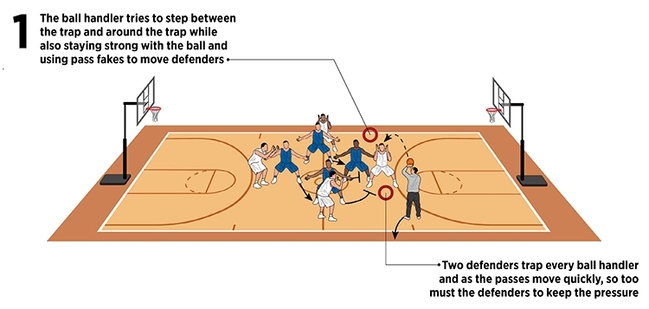
Building Defensive Dynamos: Essential Basketball Defense Drills for Youth Players
Basketball is often celebrated for its dazzling offense, highlight-reel dunks, and sharpshooting heroes. Yet, ask any seasoned coach, and they’ll tell you that defense wins championships. For youth players, understanding and executing sound defensive principles is not just about winning; it’s about developing a complete game, fostering teamwork, discipline, and a resilient mindset.
Teaching defense to young athletes presents unique challenges. Their attention spans can be short, their motor skills are still developing, and the allure of scoring often overshadows the less glamorous work of stopping an opponent. However, by breaking down complex concepts into simple, engaging drills and emphasizing effort and fundamentals, coaches can transform young players into tenacious defenders.
This article will explore a comprehensive set of basketball defense drills specifically tailored for youth players, focusing on fundamental skills, progressive complexity, and the all-important coaching philosophy to make defense fun and impactful.
The Philosophy of Youth Defense: Effort, Fundamentals, and Fun
Before diving into specific drills, it’s crucial to establish a guiding philosophy for teaching defense to young athletes:
- Emphasize Effort Over Perfection: At the youth level, effort is paramount. Celebrate every dive for a loose ball, every sprint back in transition, and every tenacious closeout. Technical perfection will come with time and repetition, but a strong work ethic starts now.
- Focus on Fundamentals: Avoid complex defensive schemes. Instead, concentrate on the basic building blocks: proper stance, footwork, communication, and understanding individual responsibilities.
- Make it Fun and Engaging: Drills should be dynamic and competitive. Incorporate scoring systems for defensive stops, positive reinforcement, and a sense of team accomplishment. If defense feels like a chore, players won’t invest in it.
- Positive Reinforcement is Key: Young players thrive on encouragement. Acknowledge good defensive plays immediately and specifically. "Great job staying low on that shuffle!" is far more effective than a generic "Good defense."
- Gradual Progression: Start with individual drills, move to partner drills, then small-group drills, and finally integrate into team concepts. Don’t rush the process.
I. Foundational Defensive Skills: The Building Blocks
Every great defender starts with a strong foundation. These drills focus on the core physical and mental components of individual defense.
1. Defensive Stance and Footwork Drills
- Objective: Develop a strong, balanced defensive stance and efficient lateral footwork (shuffling).
- A. Static Stance Hold:
- Setup: Players stand shoulder-width apart, knees bent, back straight, chest up, arms out to the sides with palms up and fingers active.
- Execution: Players hold this stance for short periods (15-30 seconds), focusing on balance and muscle engagement. Coach calls out "Up!" (stand tall) and "Down!" (get low) to practice quick transitions.
- Coaching Points: Emphasize staying low, nose over toes, and "sitting in a chair." Stress that active hands prevent passes and shots.
- B. Mirror Drill:
- Setup: Players pair up. One player (the "offensive player") stands in front of the other (the "defender"), about an arm’s length away.
- Execution: The offensive player moves laterally, forward, and backward without dribbling, trying to shake the defender. The defender’s job is to stay in their defensive stance and mirror every movement, never letting the offensive player get past them.
- Coaching Points: Focus on short, choppy shuffle steps. No crossing feet. Keep eyes on the offensive player’s chest, not the ball or feet. Encourage communication ("I’m here!").
- C. Zig-Zag Shuffle:
- Setup: Set up cones or markers in a zig-zag pattern, approximately 5-7 feet apart, extending from the baseline to half-court.
- Execution: Players shuffle defensively from one cone to the next, touching each cone with their lead hand. They must maintain a low stance throughout.
- Coaching Points: Emphasize exploding out of each change of direction, keeping a wide base, and using the lead foot to push off.
2. Communication Drills
- Objective: Develop clear, loud, and timely communication on defense.
- A. "Talk It Up" Drill:
- Setup: Any drill can incorporate this. For example, during a 2-on-2 or 3-on-3 drill.
- Execution: Before the drill starts, assign specific communication roles (e.g., "on-ball defender calls ‘ball!’, off-ball defenders call ‘help!’ or ‘shooter!’"). Players must loudly call out what they see and what their teammates should do.
- Coaching Points: Emphasize volume and clarity. Explain why communication is important (alerting teammates, preventing screens, locating shooters). Make it a non-negotiable part of every defensive possession.
3. Rebounding Drills
- Objective: Teach proper box-out technique and aggressive pursuit of the rebound.
- A. Box Out War:
- Setup: Two players start under the basket. A coach or third player stands with a ball near the free-throw line.
- Execution: The coach shoots the ball. As the shot goes up, both players try to establish inside position, making contact with their back to the opponent and forearms up. The player who successfully boxes out then goes for the rebound.
- Coaching Points: Emphasize contact (legal push, not a foul), "finding a body," getting low, and then exploding up to grab the ball with two hands.
II. On-Ball Defensive Drills: Stopping the Ball Handler
Once players understand the basic stance and footwork, they can apply it to guarding an opponent with the ball.
1. Closeout and Contest
- Objective: Teach players how to quickly and effectively close out on a shooter and contest a shot without fouling.
- Setup: One offensive player starts with the ball at the three-point line. One defensive player starts near the paint.
- Execution: The coach passes the ball to the offensive player. The defender sprints towards the offensive player, chopping their feet as they get close, and then gets into a low defensive stance with one hand high to contest the shot and the other hand active to deflect a pass or drive.
- Coaching Points: Emphasize "sprint to chop" (sprint most of the way, then short steps to regain balance). Close out with high hands, don’t jump, and stay balanced. The goal is to make the shot difficult, not to block it.
2. 1-on-1 Containment
- Objective: Teach players to stay in front of their opponent and prevent dribble penetration.
- A. 1-on-1 Full Court (No Dribble):
- Setup: One offensive player and one defensive player start at the baseline. The offensive player has the ball but cannot dribble.
- Execution: The offensive player tries to get past the defender to the opposite basket using pivots and fakes. The defender must stay in front, using their defensive stance and footwork, without reaching or fouling.
- Coaching Points: Focus on staying low, reacting to fakes, and not letting the offensive player get "hip-to-hip." This drill highlights footwork without the added complexity of the dribble.
- B. 1-on-1 Half Court (Live Dribble):
- Setup: One offensive player with a ball and one defensive player start at half-court.
- Execution: The offensive player tries to score (layup or jump shot). The defender’s primary goal is to prevent penetration, keep the ball handler in front, and force a tough shot.
- Coaching Points: Emphasize "nose on the ball" (staying directly in front), forcing the offensive player in a specific direction (e.g., sideline), and active hands to poke at the dribble or deflect passes. No reaching!
III. Off-Ball and Help Defensive Drills: Teamwork and Awareness
Defense isn’t just about guarding your man; it’s about helping your teammates. These drills introduce basic help-side principles.
1. Shell Drill (3-on-3 or 4-on-4)
- Objective: Teach players proper off-ball positioning, help-side defense, and communication. This is a foundational team defensive drill.
- Setup: Three or four offensive players spread out on the perimeter (no dribbling initially). Three or four defensive players guard them. A coach stands in the middle with a ball.
- Execution: The coach passes the ball around to different offensive players. Defenders must constantly adjust their position based on the ball’s location, maintaining the "ball-you-man" triangle.
- On-Ball Defender: Stays tight on the ball.
- One Pass Away Defender: In denial position, trying to prevent a direct pass.
- Two Passes Away Defender (Help Side): In the "help" position, usually deeper in the paint, ready to stop penetration or rotate.
- Coaching Points: Emphasize constant movement, communication ("Ball!," "Help!," "Deny!"), and seeing both the ball and their man simultaneously. Start slowly, then add dribbling and eventually shooting.
2. Help and Recover (2-on-2 or 3-on-3)
- Objective: Teach players how to step in and help a teammate who has been beaten, and then recover to their own man.
- Setup: Two offensive players and two defensive players. One offensive player starts with the ball on the wing, guarded by a defender. The second offensive player is in the corner, guarded by the second defender.
- Execution: The offensive player with the ball drives baseline. The corner defender must "help" by stepping into the paint to stop the drive. As soon as the driver picks up their dribble or passes, the helper must "recover" back to their original man.
- Coaching Points: Emphasize the timing of the help and the urgency of the recovery. Communication ("Help!") is vital. Teach players to "tag" the driver (make contact) and then sprint back.
3. Defending Screens (Basic)
- Objective: Introduce basic concepts of defending a screen.
- Setup: Two offensive players and two defensive players. One offensive player sets a screen for the other.
- Execution:
- Defender on the Screener: Calls "Screen left!" or "Screen right!" and tries to make contact with the screener to prevent them from setting a solid screen.
- Defender on the Ball Handler/Cutter: Tries to "go over" the top of the screen, staying attached to their man.
- Coaching Points: Keep it simple. Focus on communication and preventing the offensive player from using the screen effectively. At the youth level, avoiding fouls is also key.
IV. Integrating Defense into Game Situations
Finally, it’s essential to practice defense in more game-like scenarios.
1. Transition Defense Drills
- Objective: Teach players to sprint back on defense, identify the ball, and match up quickly after a turnover or missed shot.
- A. 2-on-1, 3-on-2 Continuous:
- Setup: Players line up at half-court. Two offensive players and one defender start. Or three offensive players and two defenders.
- Execution: The offensive players attack the basket. The defender tries to stop them. Once a shot is taken or a score occurs, the offensive players immediately transition to defense, and the next group of offensive players (who were waiting) quickly attacks.
- Coaching Points: Emphasize the "sprint back" mentality. The first defender back must stop the ball. Subsequent defenders must communicate and match up.
2. Defensive Scrimmage
- Objective: Apply all defensive principles in a full-game context.
- Setup: Regular 5-on-5 scrimmage.
- Execution: Coaches call out specific defensive goals: "No baseline drives!" "Force five passes before a shot!" "Get three consecutive stops!" Award points for defensive stops or successful execution of defensive principles.
- Coaching Points: Stop play frequently to correct mistakes and praise good effort. Reinforce the "why" behind each defensive action.
Coaching Tips for Sustained Defensive Development
- Be Patient and Persistent: Learning defense takes time and repetition. Don’t get discouraged by setbacks.
- Use Visual Cues: "Shadow your man," "get in a phone booth," "arms like an airplane."
- Demonstrate Correct Technique: Show them what it looks like.
- Break Down Complex Skills: Don’t overload players with too much information at once.
- Celebrate Small Victories: A good closeout, a loud call, a successful box-out – these are all wins.
- Vary Drills: Keep practice fresh and engaging by rotating drills and adding new challenges.
- Lead by Example: Show enthusiasm and energy for defense yourself.
Conclusion
Developing strong defensive habits in youth basketball players is an investment that pays dividends far beyond the scoreboard. It instills discipline, promotes teamwork, and builds a resilient mindset that extends to all aspects of life. By focusing on fundamental skills, progressive drills, and a positive, encouraging coaching philosophy, you can empower young athletes to embrace the crucial, often unsung, art of defense. Remember, defense isn’t just about stopping the other team; it’s about building complete, well-rounded basketball players who understand the true meaning of team success.



